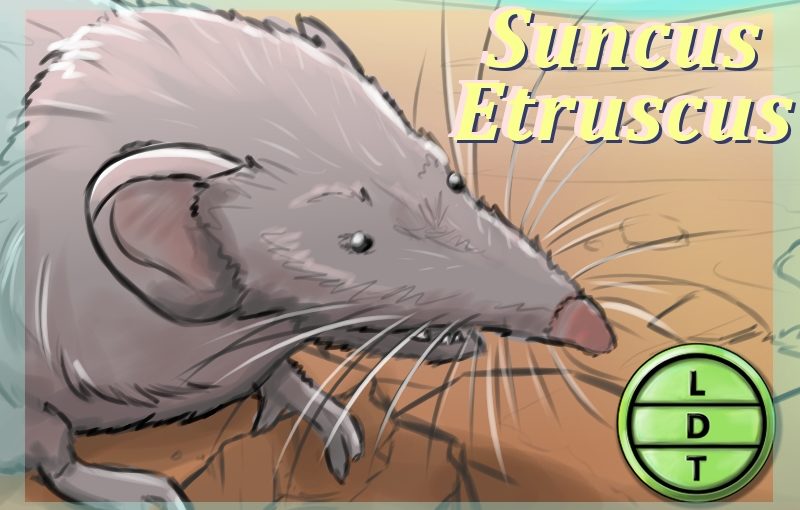“Today we are talking about a tiny mammal with a big appetite. But more on that later.”
Intro
Being tiny is difficult for a lot of reasons. It can make you easy prey for a variety of larger predators. And it can limit your own food sources to plants and even smaller animals. But being small is especially difficult for warm blooded creatures. Because of biology and physics, a small mammalian body works overtime to keep warm even in the hottest climates. For the world’s smallest mammal, it takes a lot of coal to keep their engines going. But a voracious appetite and the skills to maintain it are just what this tiny beast needs in Life, Death, and Taxonomy.
Measure Up
Welcome to the listener’s favorite part of the show (until empirical evidence shows otherwise), the part of the show where I pose quiz questions to Carlos to convey the animal’s size and dimensions in relatable terms. Welcome back to the season of woe. The season in which the questions are harder and more relatable than ever.
It’s also the part of the show that’s introduced by either a listener or an animal. If you would like to submit your own measure up intro, just say, sing, or bark the words “measure up” into your phone’s recording app and email it to ldtaxonomy at gmail dot com. Today we have a new measure up from an entire family. The Briggs family to be precise. Without further ado, the listener’s favorite part of the show!
Length without the tail
- 3 and 5.2 cm (1.2 and 2.0 in)
- Let’s call it two inches.
- How many of the worlds longest recorded eyelash (2.75 inches long) go into the etruscan shrew?
- Hint: Scientists say the optimal length for your eyelashes is a third of the width of the eye.
- Answer: One.
Weight
- 1.8 g (0.063 oz)
- If an etruscan shrew was worth its weight in gold, how much would it be worth?
- Hint: The value of gold has more than doubled since 1915.
- Answer: $86.69
Major Fact
- Anyone who’s ever held a hamster, rabbit, or even a small dog knows that little animals have quick heartbeats.
- It’s not necessarily because they’re tiny and a big creature is manhandling them.
- Small mammals need fast heartbeats just because they are so small.
- This has to do with body temperature regulation and metabolism.
- Generally speaking, mammals and birds have the unique ability to control their body temperature purely by burning food for energy and heat.
- Instead of just using food to replenish their energy reserves and heal their bodies like reptiles, they also use it to generate heat.
- Through your metabolism, you and your hamster convert food and oxygen into chemical energy.
- Do you know what in your body converts food into energy?
- That’s right. The mitochondria! The powerhouse of the cell!
- Like your computer when the fan is broken, mitochondria heat up as they work.
- For mammals, this is great news! Just by eating and breathing, which you needed to do anyway, you also stay warm.
- However, as much as you need heat to stay warm you also need to release heat or you will overheat and die.
- Animal’s physiologies are built to help in this process.
- Small things have more of their total mass touching the outside air, so they lose heat quickly.
- Large things have more of their mass on the inside, so heat from the center of their body takes longer to cool down.
- To test this, heat up a flatbread pizza and a thick calzone. The center of the calzone will stay piping hot longer than the middle of the flat bread.
- If you have a dog that is twice the size of a hamster in terms of length and width, he will have way more than twice the total mass. Why?
- Geometry. 5×5 square is 25 square feet. A 10×10 square has 100 square feet.
- Even though it’s only twice as long and wide, it’s four times larger in terms of square feet.
So what does this have to do with the shrew?
- Such a tiny mammal has a huge percentage of their total mass exposed to outside air. It loses heat rapidly, way more quickly than larger mammals.
- This little guy runs at a normal body temperature that’s similar to a human’s at 34 degrees celsius and 93.2 degrees fahrenheit.
- To compensate, the etruscan shrew has to fuel it’s mitochondria so they can burn hot constantly.
- Their bodies are oxygenated with breathing up to 800 times per minute. Humans breath 12 to 20 times per minute.
- Their hearts pump blood at a rate of 1200 times per minute.
- That takes care of the oxygen, but what about food fuel?
- Etruscan Shrews need to 200 percent of their body weight each day.
- That’s the equivalent of eating a belgian waffle with butter and syrup every minute all day.
- They can starve to death in as little as four hours.
Outro
If your appetite for interesting animal info is as high as an etruscan shrew appetite for bugs and stuff, then it’s a good idea to subscribe. Then you can get new episodes on your phone hot and ready each week. Also, did you know that the number of reviews you have can help you climb up the iTunes charts? Leaving a review can really help us grow and deliver more spicy morsels of animal knowledge to more shrewd listeners that are looking for hot new edutainment. Thanks for listening and engaging.

